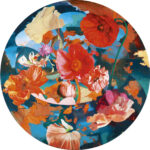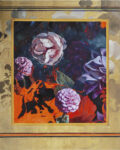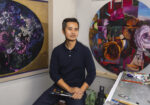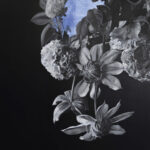Thuan Vu is an award-winning artist and educator living in New Haven, Connecticut. His paintings explore themes of national and ethnic identity, adaptation, queerness, and the process of healing and recovery. For more, visit www.thuanvu.com.
Image: Can you talk a bit about your heritage and your family’s journey to the US?
TV: I was born in Saigon in 1973, and my family left during the fall of Saigon, when I was two years old. My parents escaped with seven of their eight children—my eldest brother was detained in a concentration camp for ten years. The rest of us made it to a boat that brought us to Guam, and from there to a holding camp in Arkansas and then were resettled in New Orleans, where I grew up.
Image: How did growing up in New Orleans shape your creative outlook?
TV: In many ways, New Orleans taught me how to live: with a deep love for people, cultures, traditions, food, and music and a reverence for both the old and new. It’s a very social place, a place that slows down to enjoy the richness of life, where people of disparate classes share a real common culture. We all want to belong to something greater than ourselves, and New Orleans gave that to me.
Image: When did you begin thinking about diasporic identity in your painting? Were you ever hesitant to address a topic with such personal resonance?
TV: Trying to uncover and explore my identity has always been the driving force behind my work. Throughout college and graduate school, most of my work dealt with the melancholy I felt around my gay identity. There were a lot of brooding self-portraits and solitary figures, very angsty stuff—but art saved me.
Then when I was twenty-eight, I returned to Vietnam for the first time, which made my sense of my national and ethnic identity much more expansive and brought nuance to emotions I had always carried with me. It concretized the stories my family had told me of Vietnam but also gave me my own experience as a gay Vietnamese American man visiting his birthplace. It was difficult and vexing but also inspiring.
Image: Has the recent treatment of immigrants and refugees in the US affected how you deal with themes of dislocation?
TV: While I am painting from my own journey, knowing that there are so many lives being affected in severe and traumatic ways makes me feel much more tender about our collective humanity. I see the fractures in people, families, communities, and society, and I remind myself to stay the course: do the daily work of trying to enrich the lives of those around me in the whatever small ways I can. I paint pictures of recovered and repaired brokenness that are ultimately images of hope.
Image: What drew you to horticultural imagery? And what is the significance of working on tondo canvases?
TV: Prior to my current Kintsugi series, for seven years I painted abstractions of landscapes in a series called The New World. I was using landscape to express the feelings a refugee would experience upon arriving in a new home country—the confusion, wonder, and mystery. By painting in a circular format, I was able to keep the viewer off balance by not clearly identifying what was the sky or the ground. Gravity was brought into question. As I made these paintings, I would rotate the canvas to explore compositional arrangements that would keep me off balance as well.
After having painted the macro in that series, I naturally zoomed in on some of the smaller elements: the foliage, ponds, gardens, and flowers. Also, my partner is a passionate and gifted gardener—not by trade, just by addiction—and I get to witness the changes of the seasons through his beautiful garden right from my studio window.
Image: In the Dutch still life tradition, floral arrangements often include a memento mori. Is there a similar existential awareness in your paintings?
TV: My flower paintings depict the precarious balance between creation and destruction: flowers in full bloom caught in fragmented and broken arrangements. With the tracery of fracture so present, can we still see value and beauty in them? And can we accept this in ourselves when we confront our own limitations or traumas?
Image: Can you explain the power the concept of kintsugi has for you?
TV: My most recent series draws on the Japanese practice and philosophy of repairing broken pottery by rejoining the pieces using gold. The new piece, proudly bearing its golden scars, is seen as more beautiful for showing its history, resiliency, and ability to be transformed. My paintings were inspired by the loss of my father as well as the state of our world. In our country, beauty, hope, and decency seem tempered and hard to maintain, and thus the flowers are painted in black and white. Our ideals may seem broken and fractured, but they can be remade into a more beautiful reality. As the series progressed, the flowers gained back their glorious colors, celebrating the richness of life while showing the growing pains that come with finding a new form.
Image: The contemporary art world often seems reluctant to talk about beauty, let alone depict it. Have you encountered this ambivalence?
TV: I think art philosophers and critics talk about beauty more than artists do. I find artists talk about what excites us, what keeps us making. That’s what’s beautiful to us: the why and how of making, not what the audience or market or critics will say.
To my own detriment, I’m sure, I only paint what I want to paint and in the ways that respond to my curiosity. I choose the best visual language, techniques, and formats to communicate my ideas, and I rely on my judgment and standards for the rest. How others perceive my work is beyond my control. It’s always surprising to me when someone responds well to one of my works, because I simply made it for me.
Image: While you do not depict people, would you say there are other markers of human presence in your compositions?
TV: The human presence comes in the framing, the compositional choices, the selection of what I want the viewer to see, notice, and feel. Especially with the kintsugi
pieces, when I fracture the bouquet or leave the underpainting showing, I am making the hand of the artist apparent. My hand and eye and thinking are all evident in my work—that’s plenty of humanity.
Image: How do you begin a painting, and how do you know when it’s complete?
TV: My ideas sometimes germinate for months or years. As I go about my daily life, I’m constantly cataloging source materials and ideas for new works. Once I’ve homed in on a central idea, I make sketches using my catalog. And then I start painting.
Often technical questions will pique my interest, and that becomes part of the adventure. Whether it’s using a certain palette or experimenting with an application process, I’m engaging with things that excite me technically as well as conceptually.
When a piece is done, I feel both relief and sadness: relief because there is something new in the world; sadness because it means the end of options for this painting. This is its final form, and it will stay like this forever. The idea that no more change is possible seems too pressure filled. I always want the option to grow and change. But give me a year away from that painting and I can probably accept that it is done.












